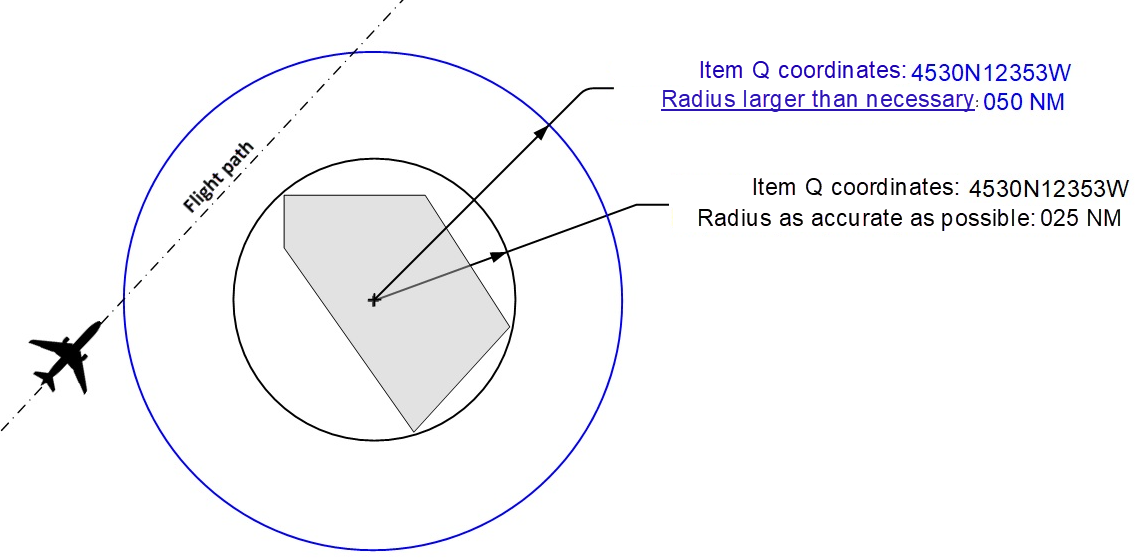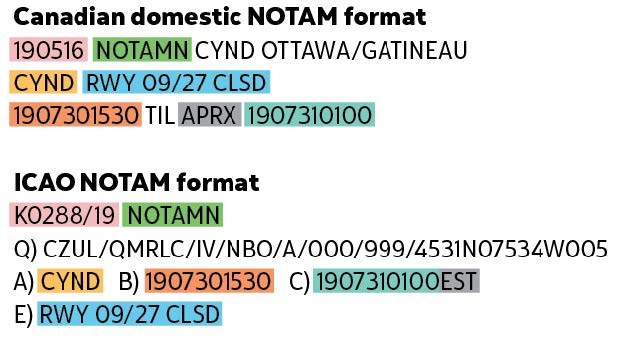by NAV CANADA
In October 2019, NAV CANADA will transition to the ICAO NOTAM format. In this article, we take a look at the upcoming changes and their potential to promote enhanced safety and usability.
Sorting through the clutter
NOTAMs contain essential information for the safe conduct of flight operations that is received on short notice. It's more than just good airmanship and best practice to check your NOTAMs before a flight—it's necessary. However, the number of NOTAMs continues to grow globally as the NOTAM users and NOTAM topics become more diverse—think of remotely piloted aircraft systems (RPAS). The volume of NOTAMs and the risk of missing critical NOTAMs are one of the top safety risks being mitigated by NAV CANADA.
For the last few decades, the NOTAM file system has been used in Canada to store and retrieve NOTAMs. NOTAM files are essentially a collection of folders similar to what would be stored on your computer. Some Aerodrome NOTAM files contain 1 or 2 aerodromes, while others contain 50, making it cumbersome to search for NOTAMs related to a specific aerodrome. With over 200 such “folders”, it can be difficult to find the relevant NOTAMs for a particular flight. Even more challenging is the fact that the number of NOTAM continues to increase, but the time a flight crew has to review NOTAMs doesn't. How can we provide NOTAMs to a crew in a way that helps them discern what is essential for their flight? The reality is that the current NOTAM file system, a system and format unique to Canada, doesn’t lend itself to sorting, whereas a format containing searchable metadata would.
Enter the ICAO NOTAM format
Starting October 2019, all Canadian NOTAMs will be created and disseminated in the ICAO NOTAM format except for RSC/ AMSCR NOTAM.
The ICAO NOTAM format, used around the world and described in Annex 15 of the Convention on International Civil Aviation, has been used in Canada for many years. Until now, it was only used to disseminate certain Canadian NOTAMs for international stakeholders. The adoption of this format within Canada will ensure compliance with international standards and eliminate the need for pilots who fly international routes to be familiar with more than one NOTAM format.
The “ ICAO NOTAM” presents information in various fields governed by strict rules, which increase the sorting potential of each NOTAM. Fields include: the subject and condition codes, the type of traffic affected (IFR or VFR or both), whether the information affects aerodrome or en-route traffic or both, vertical limits and a radius of influence centered on a latitude and longitude, among other metadata.
The NOTAM file concept will therefore cease to exist. This means that NOTAMs for an aerodrome will no longer be associated with another aerodrome’s NOTAM File. For example, in certain cases, searching NOTAMs for one aerodrome will not return data for 50 aerodromes but may only include aerodromes in the vicinity. This leads to reduced clutter but will also require careful consideration when entering search criteria to ensure you receive all NOTAMs that are relevant for your flight.
With a new format comes a new way of accessing NOTAMs. NOTAMs accessed directly from the NAV CANADA Web site will only be available on the Collaborative Flight Planning Services (CFPS) Web site, as the functionality will be removed from the Aviation Weather Web Site (AWWS). The NOTAM retrieval tool on CFPS will not require a login, but you will still need a CFPS account to file flight plans online. Whether you access NOTAMs through CFPS or a third-party application, they will no longer be presented in the old format. Also, the structure of the ICAO NOTAM provides greater potential for searching and sorting.
More information on using CFPS and guidelines on how to retrieve NOTAMs for your flight will be made available on the NAV CANADA website. Be sure to refer to the October version of the AIP ICAO which will include detailed information on the use of Series instead of NOTAM File, the country’s three NOTAM Regions, and the dissemination categories.
Successful use of the new NOTAM system requires a strict adherence by the originators to the NOTAM specifications (found in the Canadian NOTAM Operating Procedures [ CNOP]). For example, if the vertical limits and the radius of influence of the coded-line are much smaller than they should be, a NOTAM may be omitted from a briefing when it should be included. Conversely, values that are too large may cause a NOTAM to be added to a briefing when it should be omitted.
Reading the ICAO NOTAM Format
Some notions remain the same with the new format such as NOTAMN (new), NOTAMR (revision) and NOTAMC (cancellation), as well as the ten-digit date-time groups for the start and end times. The concept of aerodrome NOTAM (related to an aerodrome’s facilities or installations) or FIR NOTAM (not related to any specific aerodrome) are still used. It is incumbent on all personnel involved in flight operations to ensure that all pertinent NOTAMs are consulted. Even when flying within 25 nautical miles (NM) of an aerodrome, NOTAMs for the relevant FIR should be reviewed as missing a critical NOTAM can have serious consequences.
Although the way time periods are expressed has not changed, the terms "TIL" and "TIL APRX" are discontinued. These terms were unique to Canada. "TIL" completely disappears while "TIL APRX" is replaced with " EST" meaning "ESTIMATED end time". It should not be confused with "Eastern Standard Time". As before, all NOTAM times are in UTC. Whereas in the old format there were no times included for a permanent change, this format will show "PERM" instead. Pay close attention to time periods that start before midnight zulu and end after midnight zulu as this can often lead to confusion. You don’t want to find yourself in a restricted airspace because the NOTAM time periods were misunderstood!
The Transport Canada Aeronautical Information Manual (TC AIM) contains a comprehensive description of time periods.
The TC AIM section on NOTAMs has been completely rewritten as has the Canadian NOTAM Procedures Manual now titled the Canadian NOTAM CNOP. In addition, the details to subscribe to a NOTAM Series has been included in the AIP ICAO, section GEN 3.1.3.4.
Are you ready?
The transition to the ICAO NOTAM format will impact both NOTAM originators and NOTAM users. It is important that all impacted users understand and prepare for the coming change.
Access the NAV CANADA website for more information on the ICAO NOTAM format including a complete ICAO NOTAM briefing, specific instructions to originators, the CNOP, and the AIP. Bookmark this Web site to stay informed as additional information will be added leading up to the transition in October 2019.
Questions may be directed to icaonotam@navcanada.ca

